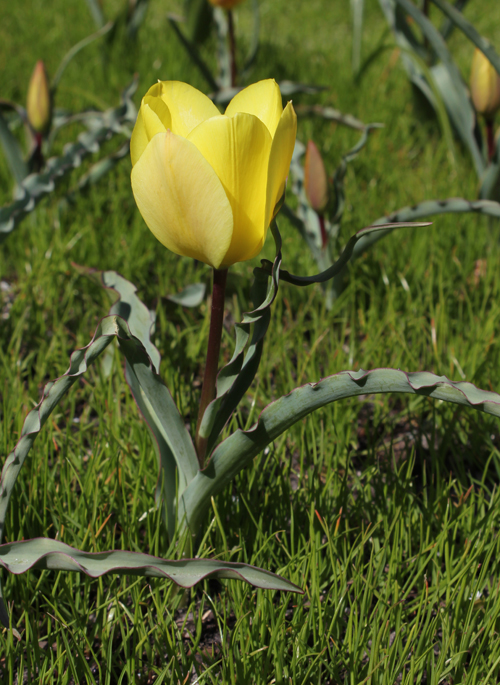Mountain tulip
(Tulipa montana)

Description
Tulipa montana, commonly known as the mountain tulip or wild tulip, is a captivating flowering plant that belongs to the Liliaceae family. This perennial herbaceous species is native to the rugged and picturesque mountainous regions of Central Asia. With its exquisite beauty and remarkable adaptability to harsh environmental conditions, Tulipa montana has earned a place of prominence among plant enthusiasts and horticulturists worldwide. Taxonomy and Classification Tulipa montana falls under the Kingdom Plantae, Division Magnoliophyta, Class Liliopsida, Order Liliales, and Family Liliaceae. It is a member of the genus Tulipa, which encompasses over 100 species of tulips. Within the genus, Tulipa montana is classified under the subgenus Tulipa, section Tulipa. Description and Morphology Tulipa montana exhibits a distinctive and striking appearance, making it easily recognizable among other tulip species. The plant features a single stem that grows to a height of around 15-30 centimeters, although in exceptional cases, it may reach up to 40 centimeters. The stem is covered in narrow, lanceolate leaves with a bluish-green hue, which form a basal rosette at the plant's base. At the apex of the stem, Tulipa montana produces a solitary flower, often cup-shaped or star-like in appearance. The flower's coloration varies widely, encompassing shades of vibrant red, orange, yellow, and even pink or white, with captivating patterns and gradients. The petals are smooth, glossy, and possess a waxy texture, making them particularly eye-catching. Each flower typically measures around 5-8 centimeters in diameter. Habitat and Distribution Tulipa montana is primarily found in the rugged and picturesque mountainous regions of Central Asia. Its natural habitat includes alpine and sub-alpine areas, typically at elevations ranging from 1,500 to 3,500 meters above sea level. The species is known to inhabit countries such as Afghanistan, Tajikistan, Uzbekistan, and Kyrgyzstan. Within these mountainous regions, Tulipa montana occupies specific habitats that are characteristic of its ecological preferences. It can be found on rocky slopes, meadows, and in rocky crevices. The plant has developed adaptations to withstand the challenges posed by these harsh environments, including cold temperatures, strong winds, and nutrient-poor soils. Tulipa montana's distribution in its native range can vary, with localized populations occurring within specific mountain ranges or valleys. These populations may exhibit some genetic variation due to isolation and unique environmental conditions. The species has not been widely cultivated outside its native range but has been introduced to botanical gardens and private collections in various parts of the world for horticultural purposes. Cultivation and Horticultural Significance The enchanting beauty and resilience of Tulipa montana have made it a sought-after species among gardeners and tulip enthusiasts. While its wild form may not be commonly available in commercial markets, various cultivated varieties have been developed, offering a wider array of colors and forms. Horticultural experts have successfully propagated Tulipa montana through seeds and bulb division methods, making it accessible to a broader audience. When cultivating Tulipa montana, it is crucial to replicate its natural habitat conditions. The plant thrives in well-drained soil with a pH range of 6 to 7.5, and it requires a significant period of winter dormancy to flower successfully. It is advisable to plant the bulbs in autumn, allowing them to experience the necessary chilling period. A sunny location or a site with partial shade is preferred for optimal growth. Ecological Importance Tulipa montana plays a crucial role in its native ecosystems. As a perennial plant, it contributes to soil stabilization and prevents erosion on mountain slopes. Its vibrant flowers serve as an essential food source for various pollinators, including bees, butterflies, and beetles. Through the process of pollination, Tulipa montana facilitates the reproduction of other plant species in its surrounding habitat, contributing to the overall biodiversity of the region. Medicinal and Cultural Significance In addition to its ornamental value, Tulipa montana holds cultural and medicinal significance in the regions where it is native. In traditional medicine, various parts of the plant, such as the bulbs and leaves, are utilized for their medicinal properties. Extracts derived from Tulipa montana are believed to possess anti-inflammatory and antioxidant properties and have been used to treat ailments such as fever, gastrointestinal disorders, and respiratory conditions. Furthermore, Tulipa montana holds cultural symbolism in the regions it inhabits. The plant is often featured in local folklore, traditional art, and celebrations, representing beauty, resilience, and the spirit of the mountains. Its captivating blooms have inspired artists and poets throughout history, further solidifying its cultural importance. Conservation Status and Threats Tulipa montana faces several threats in its native habitats, primarily due to human activities and habitat degradation. Overgrazing by livestock, unsustainable collection for horticultural purposes, and habitat destruction caused by infrastructure development pose significant challenges to the species' survival. As a result, Tulipa montana has been listed as a vulnerable species on the International Union for Conservation of Nature (IUCN) Red List. Conservation efforts, including the establishment of protected areas and the promotion of sustainable harvesting practices, are crucial for preserving Tulipa montana and its fragile ecosystems. Collaborative initiatives involving local communities, botanic gardens, and conservation organizations play a vital role in raising awareness and implementing conservation strategies. Conclusion Tulipa montana, the mountain tulip or wild tulip, stands as a botanical marvel, captivating observers with its striking beauty and ability to thrive in harsh mountainous environments. Its exquisite flowers, ranging in vibrant colors and patterns, along with its adaptability to challenging conditions, have made it a favorite among plant enthusiasts and gardeners. However, the species faces threats to its survival due to habitat degradation and unsustainable collection. Conservation efforts and awareness campaigns are crucial to protect Tulipa montana and preserve the fragile ecosystems it inhabits. By supporting sustainable harvesting practices, establishing protected areas, and engaging local communities, we can ensure the continued existence of this remarkable plant for generations to come. As we appreciate the allure of Tulipa montana, let us also recognize its ecological importance and cultural significance, honoring its role as a symbol of beauty, resilience, and the enchantment of the mountains.
Taxonomic tree:







